ABC Analysis in Inventory Management.
ABC analysis divides inventory into three categories. The “A” inventory has very tight controls and thorough records, the “C” inventory has the simplest controls, and “B” inventory is in between. This is a four minute video and provides a great deal of information on ABC analysis.
The power of artificial intelligence. We asked ChatGPT: “What is ABC Analysis?” Here is the response.
ABC analysis is a method of inventory management that is used to classify and prioritize inventory based on its value and usage. It is based on the idea that not all inventory items are equal in terms of their importance to the organization, and that different inventory management strategies should be used for different types of items.
In an ABC analysis, inventory items are typically classified into three categories:
- A items: These are the most important and valuable items, and they typically represent a small percentage of the total inventory. They are often referred to as “critical” or “strategic” items, and they require close attention and careful management.
- B items: These are less important and valuable items, and they typically represent a moderate percentage of the total inventory. They are often referred to as “important” or “tactical” items, and they require some level of management, but not as much as A items.
- C items: These are the least important and valuable items, and they typically represent a large percentage of the total inventory. They are often referred to as “non-critical” or “routine” items, and they require minimal management.
ABC analysis is typically used to help organizations identify and prioritize their inventory management efforts, and to allocate resources and attention appropriately. It can also be used to identify opportunities for cost reduction and to develop more efficient inventory management strategies.
Advantages and Disadvantages of ABC Analysis
There are a number of potential advantages to using ABC analysis, including:
- It helps organizations prioritize inventory management efforts by focusing on the most valuable items first.
- It allows organizations to allocate resources more efficiently by focusing on the items that have the greatest impact on the organization.
- It can help organizations reduce inventory costs by reducing the amount of low-value items in inventory.
There are also some potential drawbacks to using ABC analysis, including:
- It may not take into account other factors that may impact the value of an item, such as lead time or availability.
- It may not be appropriate for all types of organizations or industries.
- It may require significant effort to set up and maintain the classification system.
Overall, ABC analysis can be a useful tool for organizations looking to optimize their inventory management efforts, but it should be used in conjunction with other inventory management techniques to provide a more complete and accurate picture of an organization’s inventory needs.
Cost Savings: ABC Analysis
By categorizing inventory items into three categories based on their importance or value to the organization, ABC analysis allows organizations to prioritize their inventory management efforts and allocate resources more efficiently. This can help organizations save money by reducing inventory costs, such as storage and carrying costs.
For example, by focusing on A items, which are high-value items that represent a small percentage of the total number of items but a large percentage of the total value of the inventory, organizations can reduce the risk of stock-outs or shortages, which can lead to lost sales and customer dissatisfaction. By focusing on C items, which are low-value items that represent a large percentage of the total number of items but a small percentage of the total value of the inventory, organizations can reduce the risk of excess inventory, which can lead to higher storage and carrying costs.
Inventory Quotes
- “The goal is not to improve one measurement in isolation. The goal is to reduce operational expenses AND reduce inventories and increase throughput simultaneously.” ~Eliyahu M. Goldratt
- “Time waste differs from material waste in that there can be no salvage. The easiest of all wastes and the hardest to correct is the waste of time, because wasted time does not litter the floor like wasted material.” ~Henry Ford
- “The more inventory a company has, the less likely they will have what they need.” ~Taiichi Ohno
- “One of the great responsibilities that I have is to manage my assets wisely, so that they create value.” ~Alice Walton
- “The inventory, the value of my company, walks out the door every evening.” ~Bill Gates
- “Less emphasis on inventories, I think, may tend to dampen business cycles, because business cycles are typically in the grasp of inventory cycles and heavy industry cycles.” ~Paul Volcker
- “Make inventory a common enemy for your company.” ~Dave Waters
- “Converting a classic batch-and-queue production system to continuous flow with effective pull by the customer will double labor productivity all the way through the system (for direct, managerial, and technical workers, from raw materials to delivered product) while cutting production throughput times by 90 percent and reducing inventories in the system by 90 percent as well.” ~James P. Womack
Inventory Management Training
- Bullwhip Effect and Beer Game.
- How Amazon Receives Your Inventory.
- How Apple’s Inventory Management is So Lean.
- Improving Inventory Availability in a Volatile Supply Chain>
- Inventory Management.
- Just in Time by Toyota: The Smartest Production System in The World.
- Supply Chain Inventory Optimization.
- What Is Inventory Management?



